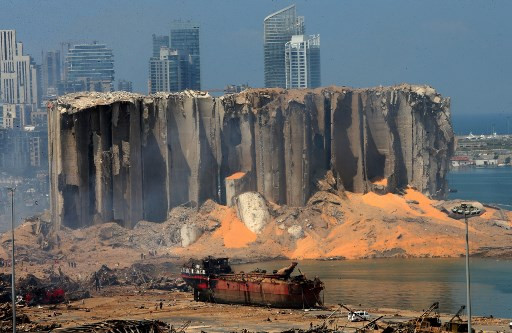Popular Reads
Top Results
Can't find what you're looking for?
View all search resultsPopular Reads
Top Results
Can't find what you're looking for?
View all search resultsAwaiting disaster, ammonium nitrate was stored at Beirut port for years
Change text size
Gift Premium Articles
to Anyone
 A picture taken on Wednesday shows the damaged grain silo and a burnt boat at Beirut's harbor, one day after a powerful twin explosion tore through Lebanon's capital, resulting from the ignition of a huge depot of ammonium nitrate at the city's main port. - Rescuers searched for survivors in Beirut after a cataclysmic explosion at the port sowed devastation across entire neighborhoods, killing more than 100 people, wounding thousands and plunging Lebanon deeper into crisis. The blast, which appeared to have been caused by a fire igniting 2,750 tons of ammonium nitrate left unsecured in a warehouse, was felt as far away as Cyprus, some 150 miles (240 kilometers) to the northwest. (STR/AFP/-)
A picture taken on Wednesday shows the damaged grain silo and a burnt boat at Beirut's harbor, one day after a powerful twin explosion tore through Lebanon's capital, resulting from the ignition of a huge depot of ammonium nitrate at the city's main port. - Rescuers searched for survivors in Beirut after a cataclysmic explosion at the port sowed devastation across entire neighborhoods, killing more than 100 people, wounding thousands and plunging Lebanon deeper into crisis. The blast, which appeared to have been caused by a fire igniting 2,750 tons of ammonium nitrate left unsecured in a warehouse, was felt as far away as Cyprus, some 150 miles (240 kilometers) to the northwest. (STR/AFP/-)
F
or at least six years, hundreds of tons of ammonium nitrate, which Lebanese authorities say caused Tuesday's massive blast, were negligently stored in a Beirut port warehouse, waiting for disaster to strike.
The odorless crystalline substance commonly used as a fertilizer has caused numerous industrial explosions over the decades -- including the massive one in Beirut that killed at least 113 people, wounded thousands and left 300,000 homeless.
A security source said the explosive power of the stored ammonium nitrate was equivalent to at least 1,200 tons of TNT -- explaining how the earthquake-strength blast destroyed or damaged so much of the city.
Lebanese port authorities and customs officials knew the chemical was being stored in the port, and one of the country's top security agencies had called for it to be relocated after launching a probe last year, several security officials told AFP.
But authorities did not heed the warning. Only on the day after the massive blast left much of the capital in ruins did the government say it was seeking house arrest for all officials involved in storing the highly-explosive substance.
With Tuesday's blast damage extending across half the Lebanese capital, the burning questions on everyone's mind are: how did so much ammonium nitrate get to Beirut in the first place and why was it stored at the port for so long?
Shady shipment
In 2013, around 2,750 tons of ammonium nitrate came into Lebanon on board the Rhosus ship, sailing from Georgia and bound for Mozambique, a security official told AFP, asking not to be named because he is not authorized to speak on the issue.
Marine Traffic, a ship tracking platform, said the Moldova-flagged vessel first arrived in Beirut's port, the country's busiest, on November 20, 2013 and never left.
According to Lebanese law firm Baroudi & Associates, which represents the vessel's crew, the Rhosus ship had faced "technical problems".
"Upon inspection of the vessel by port state control, the vessel was forbidden from sailing," the firm said in a statement.
Several security officials told AFP that it temporarily docked at the port but was later seized by authorities following a lawsuit filed by a Lebanese company against the shipowner.
Port authorities unloaded the ammonium nitrate and stored it in a rundown port warehouse with cracks in its walls, and the ship sank some time later because of damage, the officials said.
The warehouse started to exude a strange odor, which led security forces to launch a 2019 investigation that concluded that the "dangerous" chemicals needed to be removed from the premises.
The agency also noted the walls of the warehouse were unsound, urging the port authorities to repair them.
It was not until this week that workers were dispatched and began repair works, in what might have possibly triggered the blast.
Gross negligence
Shortly after Tuesday's blast, the director of customs at the port, Badri Daher, published a letter he said he had sent in December 2017 to a Lebanese prosecutor, claiming it was one of many he had sent to the judiciary over the stored chemicals.
In the 2017 letter, he allegedly requested the dangerous chemicals be exported or sold to a local Lebanese company after the army had said it had no use for them, but neither suggestion materialized.
A judicial source said prosecutors were only involved in ruling whether or not the ammonium nitrate-carrying vessel should be released and were not involved in issues pertaining to the substance's storage.
Riad Kobaissi, an investigative reporter who specializes in port corruption, charged that Daher was only trying to deflect blame by publishing the letter.
He said what has happened shows "the extent of corruption in Lebanese port customs, which is among the main bodies that bear responsibility" for the blast.
Ammong many, the disaster has only fuelled anger at a government already widely seen as inept, corrupt and beholden to sectarian interests.
On Twitter, users blamed authorities, using the hashtag "hang them from the gallows".
One user posted a photo showing several prominent Lebanese politicians with the caption: "You have to pay for burning the hearts of mothers and the future of the youth and terrorizing children."









